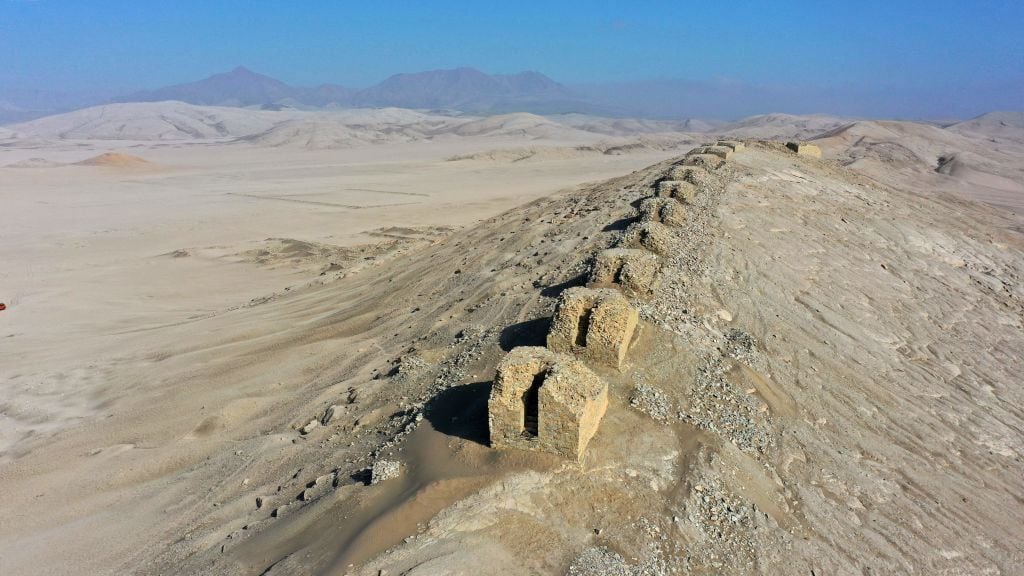
Long before the Incas came to power in Peru and began to celebrate their sun god, a little-known civilization was building the oldest known astronomical observatory in the Americas.
While not as old as Stonehenge, these ruins, known as Chankillo, are considered a “masterpiece of human creative genius,” with unique characteristics not seen anywhere else in the world.
Located in the coastal desert of Peru, the archaeological site contains a row of 13 stone towers, which together trace the horizon of a hill, from north to south, like a toothed smile.
Apart from this remarkable structure, known as the Thirteen Towers, the ruins of the observatory also include a three-walled hilltop complex called the Fortified Temple and two building complexes called the Observatory and Administrative Center.
Completed more than 2,300 years ago and abandoned in the first century of the Christian era, the site has remained a mystery to travelers for centuries.
Only when official excavations began at the beginning of the 21st century did archaeologists realize what they were looking at.
Against an arid desert landscape and in broad daylight, the stone structures on the top of the hill, stretching approximately 300 meters, do not look like much. But it's another story about sunrise and sunset.

When the Sun rises in the east, an orb of light emerges somewhere along the ridge of the towers. As the year progresses, so does the sunrise position, almost as if light flosses over the horizon full of teeth.
On the summer solstice, for example, the sunrise emerges to the right of the rightmost tower. While on the winter solstice, dawn emerges to the left of the leftmost tower.
The Chankillo Towers were placed so carefully that when a spectator stands at a specific observation point below the ridge, they can predict the time of year in two or three days from now based on sunrise or sunset alone. The observation point that faces west towards the ridge, this is the structure of the Observatory, uses the sunset. In what is believed to be the eastern observation point, all that remains is the incomplete stone outline of a room, but it is in a symmetrical location and would have used sunrise.
The September equinox, for example, is defined when the Sun sets between the sixth and seventh towers, as shown in the image below.

The ancient civilization that designed the solar observatory is hardly known, but it would have been one of the oldest cultures in America. In fact, this culture predates the Inca culture, which also stood out in astronomy, for more than 1,000 years.
Because the ruins of Chankillo attributed to this civilization lie in the coastal desert between the Casma River and the Sechin River in Peru, the original builders are now known as the Casma-Sechin culture.
Like the Incas, this civilization would probably have regarded the Sun as a deity of some kind. The stairs leading to each tower strongly suggest that the site was once used for rituals.
According to archaeological excavations, the observatory was probably built between 500 and 200 BC, then, for some reason, the site was abandoned and the towers deteriorated. In their heyday, archaeologists say that the structures would have been revoked yellow, ochre or white and painted with graffiti or fingerprints.
However, even when the decoration was removed from them and they crumbled, the remains of these stone towers still faithfully record the days of the year. Conservation efforts are now being made to maintain the accuracy of the old calendar.

In 2021, the Chankillo Archaeoastronomical Complex officially joined the UNESCO World Heritage List for its excellent craftsmanship and vision of the worldview of ancient societies.
“Unlike the architectural alignments on a single astronomical target found in many ancient sites around the world, the line of towers encompasses the entire annual sunrise and sunset arc as seen, respectively, from two distinct observation points, one of which is still clearly visible above ground ”, says the description of UNESCO.
“The Chankillo solar observatory is thus a testimony to the culmination of a long historical evolution of astronomical practices in the Casma Valley.”
KEEP READING
Últimas Noticias
Debanhi Escobar: they secured the motel where she was found lifeless in a cistern
Members of the Specialized Prosecutor's Office in Nuevo León secured the Nueva Castilla Motel as part of the investigations into the case

The oldest person in the world died at the age of 119
Kane Tanaka lived in Japan. She was born six months earlier than George Orwell, the same year that the Wright brothers first flew, and Marie Curie became the first woman to win a Nobel Prize

Macabre find in CDMX: they left a body bagged and tied in a taxi
The body was left in the back seats of the car. It was covered with black bags and tied with industrial tape
The eagles of America will face Manchester City in a duel of legends. Here are the details
The top Mexican football champion will play a match with Pep Guardiola's squad in the Lone Star Cup

Why is it good to bring dogs out to know the world when they are puppies
A so-called protection against the spread of diseases threatens the integral development of dogs



